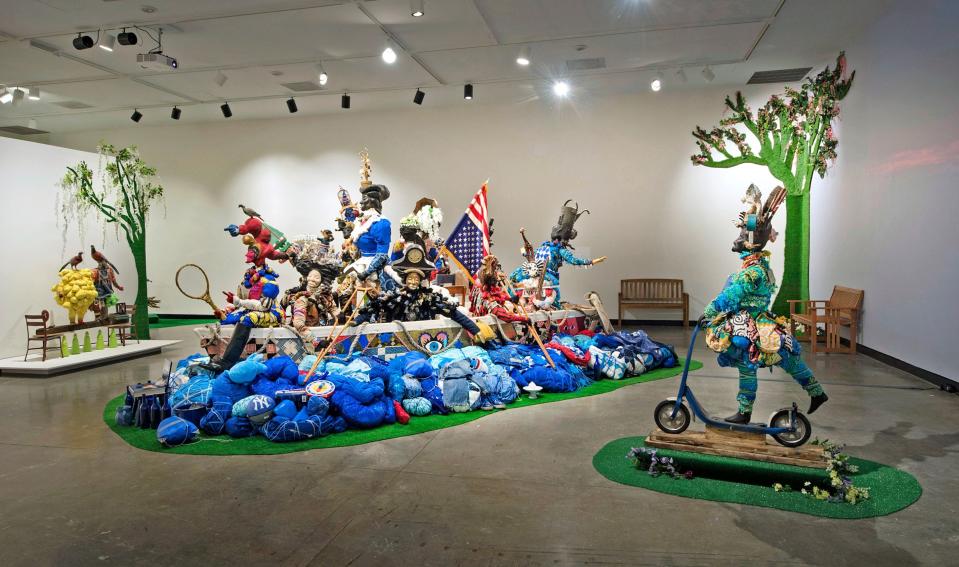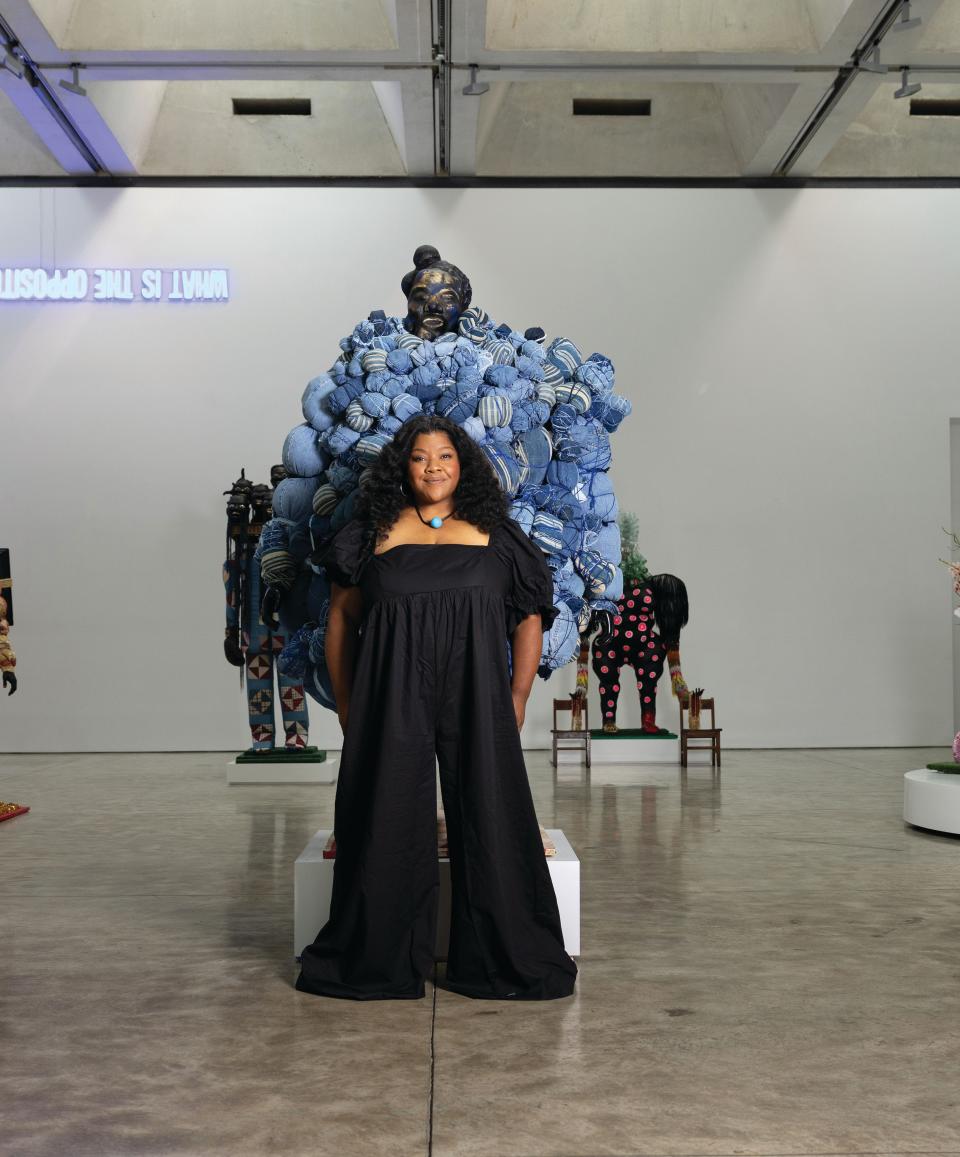'Washington Crossing the Delaware,' reimagined, at Montclair Art Museum
While The Father of Our Country was crossing the Delaware on a frigid night in December, 1776, making history as the savior of the U.S.A., what was the mother of our country doing?
Now — just in time for Women's History Month — it can be told. And artist vanessa german is just the one to tell it.
“LaQuisha Washington Crosses the Day Aware,” an enormous art installation at the Montclair Art Museum through June 25, is made up of 13 giant figures of women, "sculptural assemblage" figures made out of fabric and found objects, piloting a 16-foot boat through a river composed of quilts, pillows, toys, stuffed animals, history textbooks, a boxed VHS set of "The Little Rascals," and other nautical debris.
At the helm, standing proudly, is LaQuisha herself — a heroic Black woman with a baby in her arms. Repurposed objects are scattered throughout the piece — tennis rackets, watering cans, crutches (for oars). At the stern of the boat is a vintage advertisement: "Color can change your life. Ask us!"

When did this historical event take place? Technically, never. But then "Washington Crossing the Delaware," the iconic Emanuel Leutze painting on which "LaQuisha Washington" is riffing, has its own factual issues.
Liberty, and justice
"There were all these liberties taken with the painting," said german, the Pittsburgh based "citizen artist" (her term) who created this and the other pieces in the current exhibit at the Montclair museum, "vanessa german:...please imagine all the things I cannot say..."
"It turns out that not all these people could fit in that boat, the boat would have sunk," she said. "The river was too icy. You can't stand in a boat like that. All this fiction. It's like reality TV as a painting, right? But it means so much to the myth of strength and heroism and courage that is bestowed on the Founding Fathers."
When she came to think of an heroic figure, a different one came to mind: The Single Black Mother. Unsung, unappreciated — but in spirit, an indominable Noah, guiding her ark through hostile waters.
"I would watch Black women raise babies with an incredibly expansive space of consciousness and love and nurturing," she said "But I would also watch those same Black women be overcharged at check-cashing places." Such people, she felt, are worth celebrating.
"I wanted to place her at the center of this mythical narrative of heroism," she said.
This and that

The figures in the boat (the largest is 10 feet tall) and all the pieces in "vanessa german:...please imagine all the things I cannot say..." are extraordinary creations: made up of seashells, clocks, birdcages, sneakers, American flags, chairs, end tables, old Polaroid cameras, toys, figurines. They really have to be seen — in person — to be appreciated.
"When you see them in a photograph, it kind of flattens out the three-dimensional experience you really need to have to understand their power and beauty," said Montclair Museum chief curator Gail Stavitsky. "They're really incredible works."
The 2018 "LaQuisha Washington" piece has been on exhibit several times before. But then again, not really.
The artist vanessa german, who styles her name all-lowercase, like bell hooks and e.e. cummings ("it is a way I level myself without hierarchy") reconceives the work for each new space. In part, as a way to localize it.
North Jersey: Good rap for Paterson? Yes — at this free recording studio for youth
For the Montclair Art Museum, she availed herself of a Passaic curio shop, American Thrift. Among other things she found was the boxed set of "Little Rascals" tapes. Stymie and Buckwheat: progressive, or cringe-worthy? At various times, they've been seen as both. That's just the kind of thing german likes to incorporate into the layered complexity of her pieces.
"Everything I make is dimensional," german said. "There's a resonance of past and present and future, the cultural and the spiritual. What is the past political resonance of 'The Little Rascals'? What is the present political resonance of 'The Little Rascals'? What is the present spiritual resonance of 'The Little Rascals'?"
Everything, everywhere, all at once
You might say that german is a one-woman multiverse.
The artist, who has been seen at the The Frederick R. Weisman Art Foundation, The Nelson-Atkins Museum of Art, The Crystal Bridges Museum of American Art, and a Smithsonian Museum touring exhibit, creates work that functions on multiple levels — not least because she functions on multiple levels. She sculpts, paints, writes, performs, advocates. Nothing is in a box.
"I am an artist, and being an artist for me is a whole and complete human identity," she said. "It's not simply a profession. This is an entire way to inhabit an existence as a human bring."
As a self-taught virtuoso who came up outside the mainstream art world, german learned from her mother — herself a fabric artist — to try everything, use everything. So she does. Old shoes? Shells? Pine cones? Stuffed animals? If it speaks to her, it ends up in her storehouse. Eventually, it may end up in one of her works.
NJ: This Jersey Shore rocker made The King a bad-ass spy on new Netflix comedy 'Agent Elvis'
"If I'm outside on a walk and see dead wood that has fallen from a tree, it it communicates to me as an artistic material, then I'm going to pick it up," she said.
What is constant, in her varied output, is the need to upend old narratives, question old myths.
Happy ending?
The artist, who came to Pittsburgh by way of her native Milwaukee, Los Angeles, and Loveland Ohio, has lived in some pretty grim places — not least Homewood, a notoriously dangerous neighborhood of Pittsburgh. She can't afford illusions.
"I got such severe PTSD from watching people get killed and dying in the street," she said "I think about the amount of people in this county who have been witness to mass shootings, and how incredibly horrific and difficult it is to try to unsee the things you've seen."
All the more reason to celebrate the heroes who steer their ship through such troubled seas. Especially women, and people of color. We in the museum can't see where LaQuisha Washington is piloting her boat. But german thinks she knows. A better place, she says.
"It is literally on a river of existence, moving to a place where all human beings can live with love, courage and freedom, and safely inhabit their humanity with wholeness," she said. "That's where the boat is going."
If you go...
"vanessa german:...please imagine all the things I cannot say..." Montclair Art Museum, 3 S. Mountain Ave, Montclair. 973-746-5555 or montclairartmuseum.org.
This article originally appeared on NorthJersey.com: 'Washington Crossing the Delaware' is reimagined at Montclair museum

